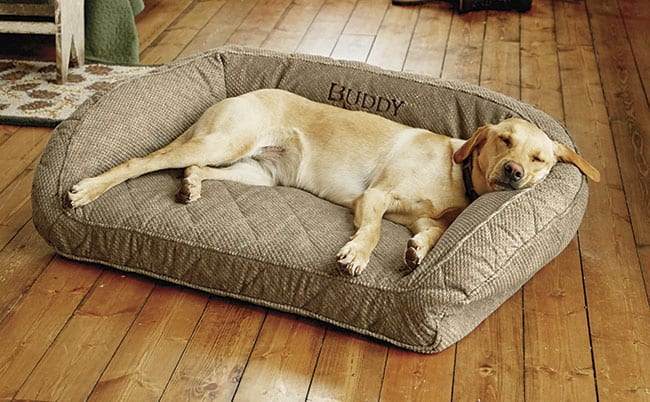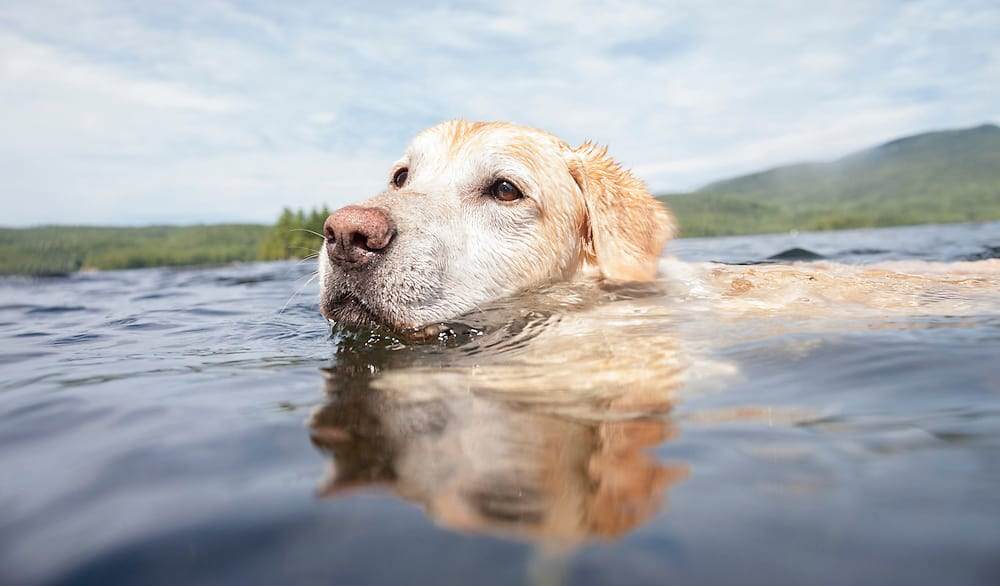I keep on repeating in every Labrador related article on my website that they are the most popular dog breed in the United States and have a long history of 200+ years. On social media, I do get queries on how much will it cost to own a Labrador dog.
So this article will inform you what are the various heads under which the money has to be spent. I will also give an approximate figure which is calculated by surveying the marker.
There are a number of parameters on which the final cost of a Lab dog has to be decided. For complete ownership till his lifetime, you should be looking at 10,000 to 12,000 US dollars. The average lifetime is 10-12 years for a lab dog. Hence $1000 per year is the average cost of owning a Labrador dog.
The upfront cost of purchasing a Lab puppy from any good breeder is $700 to $1000. After that, there are costs like a crate, food, toys, clothes, grooming, etc which are discussed in more detail below.
I must say here that the benefits of owning a Labrador outweighs the cost that you bear. They are popular dog breeds in the USA for some reason. The agility, hunting, guard dog, social and healthy body is what makes them popular.
So if you have the money and still thinking about owning a Lab puppy then I would strongly recommend that you get a Labrador dog.
Variation in the Price of a Labrador Dog
Like any other commodity, the price of a Labrador dog varies significantly. This is determined by the market forces of demand and supply. The age, health status, and level of expertise of the dog of choice also come in.
These variations definitely impact on the subsequent affordability of the dogs altogether. Generally speaking, the elderly and skilled Labrador dogs cost more than their younger and rudimentary counterparts.
This stems from the higher value you are more likely to accrue from them. You hence have to factor these considerations as you search for the right dog. Be mindful of the kind of use you want to devote your dog to.
Avoid Profit Making Backyard Breeders
For your own utility and to gain the most from these dogs, you are advised to shy away from the backyard breeders. These are amateur animal breeders whose breeding regimens are substandard. Their primary motive, as a matter of fact, is pure profit; nothing more.
They are unlikely to undertake selective breeding, neither do they make any effort towards matters of ethics and skill development. While you may save yourself some bucks, the quality of services you are likely to obtain from them is way too substandard.
Instead, opt for those who are skilled and reliable in the trade. These are certified by the various accreditation agencies and also hire professional breeders. You will never live to regret that move at all.
Whether You Should Adopt a Rescue/Shelter Labrador
Though you have the liberty to acquire your dogs from wherever the rescue/shelter sources are much better. Below are some of the benefits that come along:
Life-saving
By choosing to travel this route, you get to save a life. Many of these dogs are sourced from conditions that are deplorable, to say the least. This is definitely a good thing to do as you will also contribute to saving your environment.
Personally Gratifying
You will also get to accrue some sense of personal gratification in so doing. That is because you will get to witness the dog you rescued blossoming and getting back on its feet after suffering some trauma.
Unconditional Love
In return, you will enjoy some unconditional love from the dog. Such a dog is naturally grateful for the favor you have done to it. It shall showcase this love by the tenderness with which it handles you.

Food Costs for a Lab Puppy and Grown Up Lab
The food consumption, and by extension, the costs thereof depend on the age and weight of the dogs and puppies altogether. Below is a breakdown of the food consumption patterns and trends for your puppies and grown-up dogs:
a.) Puppy
>2 months
15-18 pounds; 7-9 ounces daily; 4 meals per day; 2 ounces per meal
>3 months
24-26 pounds; 9-11 ounces daily; 3 meals per day; 3-3.5 ounces per meal
>6 months
50-60 pounds; 12-16 ounces daily; 2 meals per day; 6-8 ounces per meal
b.) Grownup labs
>Female
55-70 pounds; 30-36 ounces daily; 2 meals per day; 15-18 ounces per meal
>Males
65-80 pounds; 36-40 ounces daily; 2 meals per day; 18-329 ounces per meal
NB: The actual costs vary from food to food and area to area. Use the guide we have stipulated above as the basis of determining the exact value. Please note also that the actual amounts may also vary significantly from dog to dog and in responses to the climatic changes.
Other Daily and One Time Costs of Owning Labrador
Other than the food, you will need to incur some added expenses to maintain these dogs in a proper state of health. These expenses pertain to their shelter and overall health maintenance. In this segment of the discussion, we are going to look into those added expenses and where they touch most.
Crate
Also called a cage, the crate is a fabric, wire, plastic or metal enclosure for your dogs. It contains a door that regulates the entry and exit of the dog into and out of the said enclosure. You use the crate to transport the dog back and forth a designated location.
Needless to point out, the size of this crate depends on the size and breed of dogs. Larger and bulkier dogs similarly require stronger and tougher cages and vice versa. Then again your desired duration of use comes. If you are looking for a one-time use, then any cage might do. This is the crate on Amazon that I always recommend.
You have to insist on a stronger and more durable variant though if you plan to use the cage repeatedly and for a prolonged duration of time. That is to guard against the risks that come along with damages and other agents of deterioration. You also want to push down your maintenance costs.

Puppy Training Pee Pads and Fence
From time to time, you will also want to train your puppies. For this, you will have to acquire some co-operant tools-of-trade. The training pee pads and fence are perhaps two of the most outstanding. It is on them that your dog rests while it takes up cues from you.
The fence encloses the training area to see to it that your puppy does not stray away from its boundaries in the course of being trained. Yet again, the actual costs of these two vital pieces of training equipment depend largely on the nature of your dog and training expectations.
Larger, elderly, weightier, and aggressive dogs require gears that are stronger and resistant to the common agents of the tear. Such gears similarly cost more to come by as they are more likely to be more durable. Be prepared hence to part with the needful amount of money.
Various Types of Vet Expenses for Labrador Retriever
Apart from furnishing the dog with food and the necessary training gears, you will also have to incur some veterinary expenses from time to time. These are necessary to maintain the health of your pet dog in the best shape and form all the time. Below are some kinds of services you will make do with:
1. Vaccinations
You need to take your dog to be vaccinated against the major diseases. These include the Canine Parvovirus, Canine Distemper. Canine Adenovirus, Parainfluenza, Kennel Cough, and Leptospirosis. To do this better, you will have to adhere to some strict schedules.
2. Inspections
It is never enough to solve problems as they arise. Some problems are better averted rather than sorted out after they have already taken place. That is why it makes sense taking your canine for inspections or inviting a veterinarian to come to your place.
3. Treatments
If and when your dog falls sick, it has to be given the necessary treatment. Yet again, the veterinarians come in handy at such times. They administer the relevant treatment using the standard procedures recommended for the ailment.
4. Laboratory
Some health issues require that samples of the blood or stool of your dog be taken and analyzed at the laboratory. The veterinarians have the equipment, skill, and expertise needed for this role. That is why you will have to delegate to them the duty for their undertaking.
5. Dietary
Just like humans, dogs too have certain dietary preferences. Moreover, they too are susceptible to allergies and other issues that affect the kinds of foods they might eat. It is also in order for you to take them to a veterinarian to identify these preferences and make appropriate room and consideration for them.
6. Behavioral Counseling
Lastly, veterinarians also deal with behavioral counseling. They come in to help you tame your dog should it become wayward or unwilling to toe the line. You badly want the assistance of the veterinarians if your dog occasionally turns wild on you or the people concerned.
Other Miscellaneous Expenses
Further to the food, crate and veterinary services we have explained above, you will incur some miscellaneous expenses in the course of bringing your dog up. Listed and explained hereunder are the host of additional expenses that you inevitably have to incur.
1. A Dog Bed
Definitely, your dog will have to lie somewhere. The dog bed it is! In a nutshell, the dog bed is the structure that provides the support and strength necessary to carry your dog through the night. It is warm, soft, and large enough to handle your dog well.
Finding a bed is not as simple as it might sound. There are a number of factors you have to care for while seeking the bed of your choice and liking. The size and weight of your dogs, desired levels of comfort, and the financial resource endowment are some of these determinant aspects.

2. Other Expenses
Then there is the need to care for several other minor expenses. These combine to impact greatly on the total amount of money you will inevitably have to part with. They are used to cover items like towels, water bottles, food scooper, and carpet cleaners.
Like the bed explained above, these expenses also vary largely with the kind of dog you have in your possession. Those dogs that are heavy consumers are more likely to inflict excessive costs on your part. This stems from the need to invest more for the sake of meeting their needs.
The good news though is the fact that these expenses are not fixed. That means to some extent you have some say on just how much you are likely to make use of or incur in the course of so doing. It is hence incumbent upon you to determine just how much you might be willing to part with, in the process.
3. Toys
The idea of giving your Labrador dog some toys might sound ridiculous. Believe me though that dogs too get bored much as humans do. To stem this boredom, you also have to give them the toys they need to stay lively and full of hope.
It is for this reason that you also want to explore the possibility of giving them some toys. Some of the toys you might think of are tennis balls, chew toys, dental dinosaurs, and balls. They have been noted to completely captivate the attention of the dogs.
Grand Total of all Costs (Ballpark Figure)
Compared to many other breeds, the Labrador dog costs more to maintain. This is understandable owing to the many extra benefits they bring along. Also, their longevity and intellect make them the best choice as compared to other alternatives.
Whilst the cost of maintenance varies greatly from city to city, expect to spend around $500 yearly. This figure can sometimes triple, depending on your medical expenses and other incidentals that surround their growth and overall maintenance.
Despite the Costs, Benefits of Owning a Labrador retriever
The cost of maintaining a Labrador is definitely high; from what we have seen above. This notwithstanding, there are several benefits that come along with so doing. In this last segment, we are going to look into these fringe benefits.
This approach, we hope, will give you more than enough reasons to purchase one, the prohibitive costs notwithstanding.
1. Good Natured
Compared to the other breeds, the Labrador is well-natured. It rarely loses its cool even under extreme provocation. That is why it is safer for use in the home environment. Take advantage of the dog to complete the warmth and comfort of your own home.
2. Highly Dependable
A Labrador is a breed you can count on. When properly indoctrinated, it sticks to the laid down routines faithfully. Rarely does it digress and engage in other kinds of activities that are outside the patterns and training you will have given it before?
3. Highly Intelligent
The Labrador is yet again more intelligent than the other dogs which compare to it. This is evidenced by the faster speeds with which it absorbs new concepts, the faster pace with which it adapts to the new environment, and the ease with which it acquires new skills on the whole.
4. Pleasant and Joyful
Generally speaking, the Labrador is a pleasant and joyful dog. It is hardly affected by the issues of stress, depressions, and provocations. By adding the Labrador to your home, you may count on it to add some life and elegance there as well. This is not to mention being good for your children and guests.
5. Excellent Swimmers
Do you have some swimming pool right where you are? We ask that you incorporate the Labrador in your homestead, yet again. These dogs are excellent swimmers. They never capsize in water even when they trip into it unexpectedly as other breeds do. You may also bring them along to help your children have fun in the water.

6. Easy to Find
Aware of the major benefits of this dog breed, many players are engaged in the breeding and sales of this species. You will hence find this species just about any other place. By not having to strain you unnecessarily, you get to enjoy some convenience too in the course of searching for them.
7. Very Trainable
As hinted above, the Labrador is a very intelligent breed of dog. You will easily impart on it the skills necessary to take on several tasks and chores. Closely related to this is the issue of not having to spend too much in the course of doing so. You will spend more, granted. However, the sum total benefits you accrue are also too huge to forfeit.
8. Easy Going
Due to their cheerful and playful nature, the Labrador is easy going. It mingles easily with the rest of the occupants of your home like the children and guests. This again goes a long way in making this dog a vital possession. You may, for instance, use the dog to enhance some life and pomp besides the core value of enhancing your security.
Conclusion on the Overall Price of Labrador
By now, you would agree that owning a Labrador dog will cost quite a good amount of money. However, if you are a dog lover and wish to own a Lab dog then definitely you should get one. The happiness and confidence that the Lab dog will bring to your life are too good to have.
References
Table of Contents
